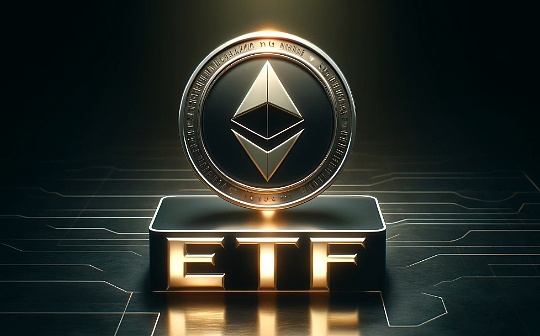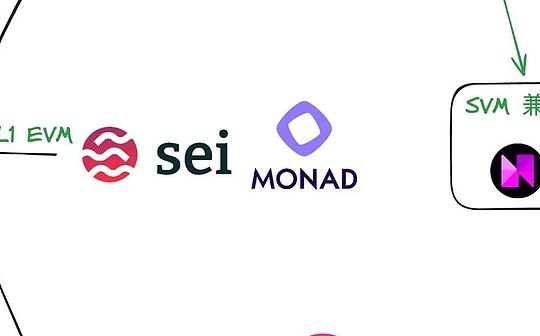
The competition of Alt L1 has been heated. Near has launched a DA solution. SUI’s TVL has risen all the way. Only Ethereum is still not slow.L2 emerges two competition points of parallel EVM and decentralized sorters.
In the present and future, a basic fact is that the status of Ethereum is already difficult to shake, and the concept of modularization will be generalized. If Vitalik’s suppression of Celestia is unsuccessful, the market will choose. Combination and modularization will not only occur in the same time in the same time.In the system, marketing principles will promote the project party’s free assembly elements, such as the availability of the combination of each public chain, L2 and Bitcoin, and the hotness of BTC L2 is evidence.
If Near can do DA work, then high -performance public chains such as Aptos, Solana, and SUI can be “L2” and eventually compatible and annexed by Ethereum.
Parallel EVM can be understood as parallel EVM compatible chain/L2, which can start from the speed of the blockchain. In theory, there are only two methods to solve the slow operation of the blockchain:
-
Adding hardware and constantly tuning.For example, SLANA’s hardware configuration is unique, and the management and configuration of the “computer room” allows Solana to enjoy ultra -high network speed and increase throughput;
-
Multi -core parallel, multi -line concurrency.After the hardware improvement, multi -core can truly achieve multi -tasks. In addition, it can be refined and refined by the task, which can improve efficiency. This is also a common computer approach.
The default hardware utilization has reached the ultimate, so the parallel EVM can be classified and understood from the following three levels:
-
The parallelism is a common practice in the computer field.EssenceFor example, ALT L1, such as APTOS, SUI, and Solana, or SEI, claiming that he is the first L1 compatible with EVM, and Scroll (2024 route map), Lumio, Eclipse and other Ethereum L2 projects, as well as Neon EVM and other isterior chainsCompatible with EVM solutions, Neon EVM belongs to the Solana ecosystem, and also claims that he is the first compatible EVM.
-
Parallel EVM refers to L1/L2, which can be compatible with EVM in a narrow senseIn theory, Ethereum can also implement parallel transformation. This is the most defined parallel EVM, but it is almost impossible to exist;
-
The parallel EVM can be expanded in a broad sense, arbitrarily parallel computing chainRegardless of whether it is compatible with EVM, as long as it can be opened with the EVM link, it can be attributed, such as using Aptos as an “accelerator” of Ethereum.
-
Huaqiang is going to buy a watermelon. This is a single line, also the smallest unit, and a thread. A watermelon is a physical hardware resource that can be called at this time.
-
The two Huaqiang wants to buy a watermelon together. This is a composite behavior, because there are two Huaqiang to eat melon, but it should be noted that there is still only one watermelon at this time, and there is no more.And the two Huaqiang made an appointment to cut watermelon together. Whoever does not go is not a brother, then at this time, the two Huaqiang buying melon is a process. Each Huaqiang eating melon is still a thread, so one process includes two in one process.Thread.
-
During the sorting phase, Block-STM uses STM to sort the transaction to ensure the order of the transaction;
-
During the execution phase, Block-Stm uses sort results to perform trading parallel to improve execution efficiency.
-
APTOS: ALICE account minus 1 USDT, BOB account plus 1 USDT, involving the account information and balance changes of the two accounts;
-
SUI: 1 USDT remains unchanged, only changes its ownership attributes, and changes ownership from Alice to BOB, which only involves 1 USDT information change;
-
Sealevel -Parallel Processing Thousands of Smart Contracts
-
AWESOME-PARALLEL-Blockchain
-
Parallel Computing
-
INTRODUCTION to Parallel Computing Tutorial
-
SEI V2 -The First Paralized EVM Blockchain
-
https://docs.monad.xyz/
-
MT Capital: UndersTnding Parallel EVM: Project OverView and Future Perspectives
-
Parallel Power Unlocked
-
https://neonevm.org/whitepaper.pdf
-
Block-Stm: Scaling Blockchain Execution by Turning Ordering Curse to A Performance Blessing
-
https://github.com/madnlabs/sui/blob/main/doc/paper/sui.pdf
-
Built for Speed: Under the Hoods of Aptos and Sui
-
Innovating the main chain: a polygon pos Study in Parallelization
The ALT L1 compatible with EVM is also of special significance. They can be connected to the EVM ecosystem. In addition, the Block-Stm scheme created by APTOS has also become the source of many emerging parallel EVM schemes. The following will be detailed.
Pre -front: thread, process, parallel and concurrent and EVM’s popular description
I classify the idea of disassembling parallel EVM, but it is still incomplete to explain the concept of parallel. If the logic of the project realization is directly talked about, it will make people unprerently.
Similarly, like “The process is the smallest unit of resource allocation. The thread is the smallest unit of the CPU schedulingAlthough the explanation such as is professional, it is not very friendly to most people. I want to use buying melon as an example to explain this process.
Let’s pave the way. The bottom layer of our computer is physical hardware, and it is the operating system and various applications. When the computer handles the task, it is distributed according to the priority.The
>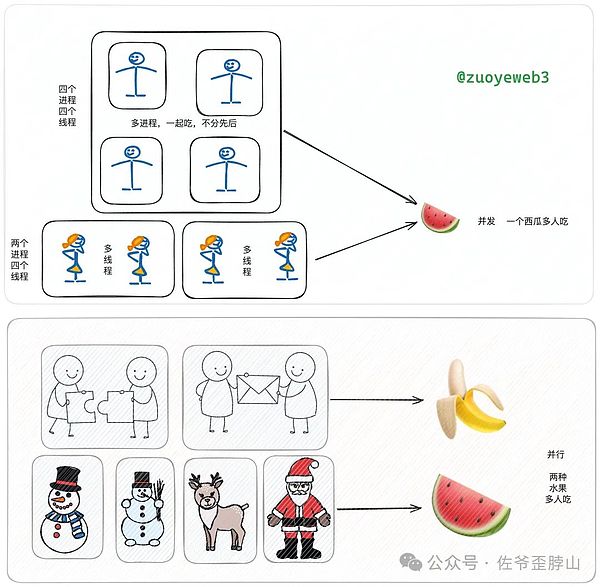
At this time, there is only one watermelon, but the situation where many people eat are concurrent. The focus here is that everyone eats watermelon together. To ensure that everyone can eat at least, because no matter how much people eat melon, how many people eat melon, and how they are between them and how they are between them and how they are between them.Seating and seasons will not affect the final result of eating more melon.
Smart you must see the problem. Why do you have to eat watermelon together so many people? The owner of the watermelon stall is essentially a fruit shop owner. You can also eat bananas.The reason is that the boss announced that the banana is also listed, so at this time the physical resources (fruit) have increased. Huaqiang can be divided into two columns to eat different fruits.
(Anti -bumper statement: The above explanation is more popular but unprofessional.
In the next step, they are combined with EVM to assemble the true meaning of parallel EVM.
Although EVM is often mentioned, it is really confused, especially the virtual machine (VM, Virtual Machine) always gives people a sense of reality and virtuality. In fact, it is not true that virtual machines are specialization.The operating system, programmers do not need to develop in physical entities, they only need to be adapted at the software level.
Simplify the role of EVM is the transaction. The user submits instructions. Then EVM will follow the user’s needs, such as transfer, SWAP, pledge, or other acts that need to interact with smart contracts will be executed one by one.The focus here is instructions and one -to -one execution. EVM can understand the needs of users, but the execution needs to be queued and cannot change the order at will.
Therefore, the parallel EVM is essentially changing the order of execution. Multiple smart contracts (instructions) are allowed to be carried out at the same time, which is equivalent to hiring the owner of the stall. He sells watermelon and the younger brother sells bananas. He finally earns money and is still the boss.
>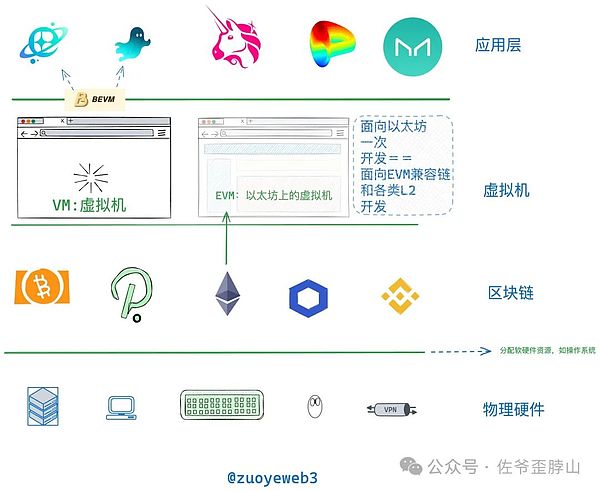
The most typical is the BTC L2 mentioned in the previous article. Now the BTC L2 basically wants to access the EVM ecosystem for Bitcoin. In fact, they are a virtual machine on Bitcoin. Developers develop them for them.There is no need to consider the restrictions on Bitcoin’s own architecture and programming language. You can use the familiar EVM development process in one step.
EVM is the same, and it is extreme. If you are a front end, you can even develop to the document on the basis of the principle of hardware, operating system principles, and Ethereum principles. You only need to understand the EVM development tools and interface descriptions.For example, write the front -end interface of a certain DEX (only the theoretical explanation is actually very complicated).
In a word, the virtual machine (VM) is a processing workshop after the hardware and principles. For example, when Huaqiang buys melon to make watermelon juice, the virtual machine is a juicer. A glass of watermelon juice only requires three steps: open lid, and the lid is opened,Put in watermelon, squeeze juice, finish.
In the same way, EVM is the juicer of Ethereum, compatible with EVM is the Pinduoduo juicer bought by L1/L2. Although there are some flaws, it can also be used, and the parallel EVM is a number of juicers work together.
It is not that it can’t afford it by hand, but the juicer is more cost -effective.
Finally, the concept of parallel EVM is re -emerged from the rivers and lakes. In essence, Ethereum can only process the speed limit brought by a single transaction in order.It can only be mentioned that around 200, under the premise that the physical hardware has no revolutionary breakthrough, and Ethereum itself cannot be transformed into a parallel mechanism, the parallel EVM track will be hot for a long time. After all, no one will think it is fast.
Status: optimistic verification becomes a consensus, and the MOVE department gradually has the trend of rescue
并行和VM 的概念早已有之,但是引入到区块链,尤其是并行EVM 概念,其实是以2022 年为起点,Aptos 发布了《Block-STM: Scaling Blockchain Execution by Turning Ordering Curse to a Performance Blessing》The papers, then the Polygon POS chain tried to join the function at the end of the year. Not only that, many plans and ideas put forward in this paper in this paper have also become a common choice for the industry and need to be introduced.
>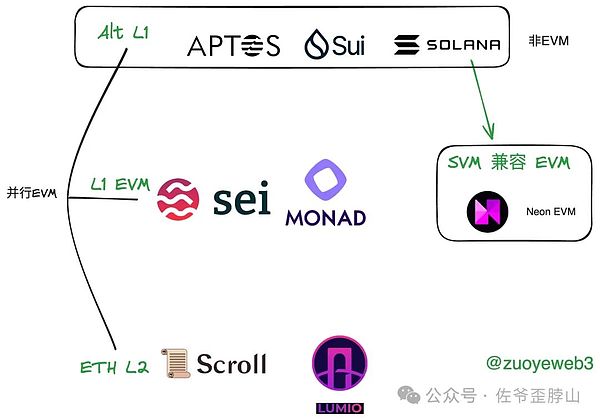
Dream of remembrance: block-stm
It can be said that APTOS is a large -scale integrated blockchain. Although Solana and Near have explored, the STM (software transaction memory, Software Transactional Memory) applied in the blockchain in the blockchain re -sorted the transaction.The core idea is to assume that the transactions after sorting are right, and it is found that there are wrong ones after parallel execution. Solving individual wrongs alone, according to the law of the 28th, so that most of the transactions can be accelerated.It is basically the same as the optimistic verification mechanism in Rollup.
>
Specifically, the Block-STM divides the execution process of the blockchain into two stages: the sorting phase and the execution phase.
The parallel EVM since then is basically similar to this, but there are differences in sorting and execution, and to increase compatibility with EVM. For example, neon EVM and Polygon POS belong to this category.
SUI transformation: everything is object
The SUI and APTOS divisions are in the same door. The two are similar, but the biggest difference is that the SUI is based on Object.
As you can see, the starting point of the SUI is not to examine the accounts of both parties in the transaction, but the attribute changes involving objects. As a result, it is not only token transfer, but also assets such as NFT.
Extending again, if an asset involves only the changes between the attributes between the points, the whole node does not need to be synchronized. As long as the two parties recognize the transaction, this kind of transaction can be processed in parallel.
Of course, the specific implementation of the two is much more complicated, and the parallel will also bring a lot of problems, but it is enough to understand that it is enough.
Solana and Neon EVM: Lystronomy listing
Solana’s parallel processing is achieved through the Sea Level mechanism, similar to Block-STM (in fact, it should be reversed, Sea Level proposed in 2019, Block-Stm proposed in 2022), all need to be sorted in transactions, and then execute.
Solana’s “innovation” lies in the special optimization of hardware resources. Theoretically, not only can all instructions be sorted, but the optimized multi -threading can exert the entire efficiency of the processor to achieve the effect of high and merging.The peak can reach about 5,000.
So what is the relationship between NEON EVM?
>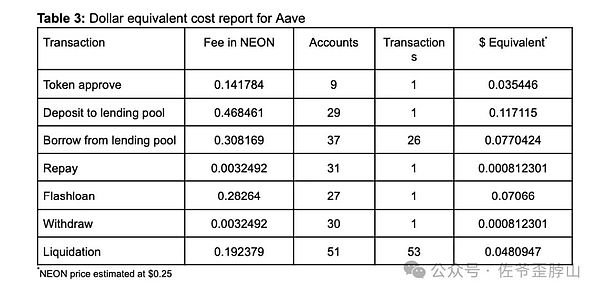
What NEON has to do is to synchronize EVM’s transaction information, and then use Solana to calculate it.NEON’s authorization, transfer, and deposit are basically less than $ 0.1 or even 0.01 US dollars.
Inadequately speaking, Neon turned Solana into an alternative L2 of Ethereum, bypassing, L1/L2 EVM can not only achieve parallel itself, but can also be agreed.The remaining part of the outsourcing out.
This is also the beginning. I said that the true meaning of generalized modularization. L1/L2 parallel EVM can be a combination product of three projects, or even cross -chain combinations. In this way, the gameplay is diverse.
SEI V2 and Monad: Happy together, compatible with bytes
In terms of technical implementation, SEI V2 and Monad are very similar. Both are compatible EVMs of Ethereum. In fact, they have chosen familiar optimistic verifications in parallel thinking.Execute, go wrong, and solve the dependency items separately.
>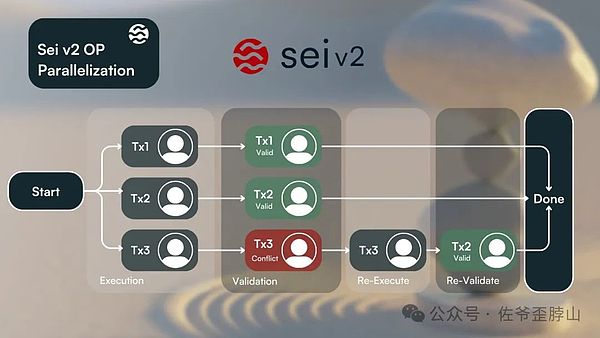
Of course, everyone can use mature products and ideas, but it should be noted that, just like BTC L2, there are not many real technological innovation. It is still based on “combination”. Solana is the only large -scale practice parallel, and software and hardware matchingThe other L1 with high concurrency effect is more “compatible with EVM+parallel” package.
Everyone must have thought that since Solana can be regarded as an accelerator, then APTOS and so on. In fact, Lumio also think so. As long as you are an intermediary, you are compatible with EVM, and on the one hand, you can be called parallel EVM, so therefore, it can be called parallel EVM.Do not explain too much to Lumio.
Conclusion: the dilemma of parallel EVM
In this article, I emphasize that the core of parallel EVM is the deployment of hardware resources and the ranking of tasks., But parallel EVM is currently the transformation and imitation of APTOS’s block-stm, which is also the basic fact.
In addition, there is no need to excessively explore parallel practice on the Ethereum L2. They also need to solve the centralized problem of sorters, and the efficiency is high enough.
The parallel EVM is not mysterious. I saved the technical details such as the design and writing mechanism design of each project, TPS comparison, data records and status synchronization. Ordinary people do not need to understand these things at all.Full of the audience, optimistic verification is to execute the wrong idea first. If there is update, I will add it in time for everyone.
References:

